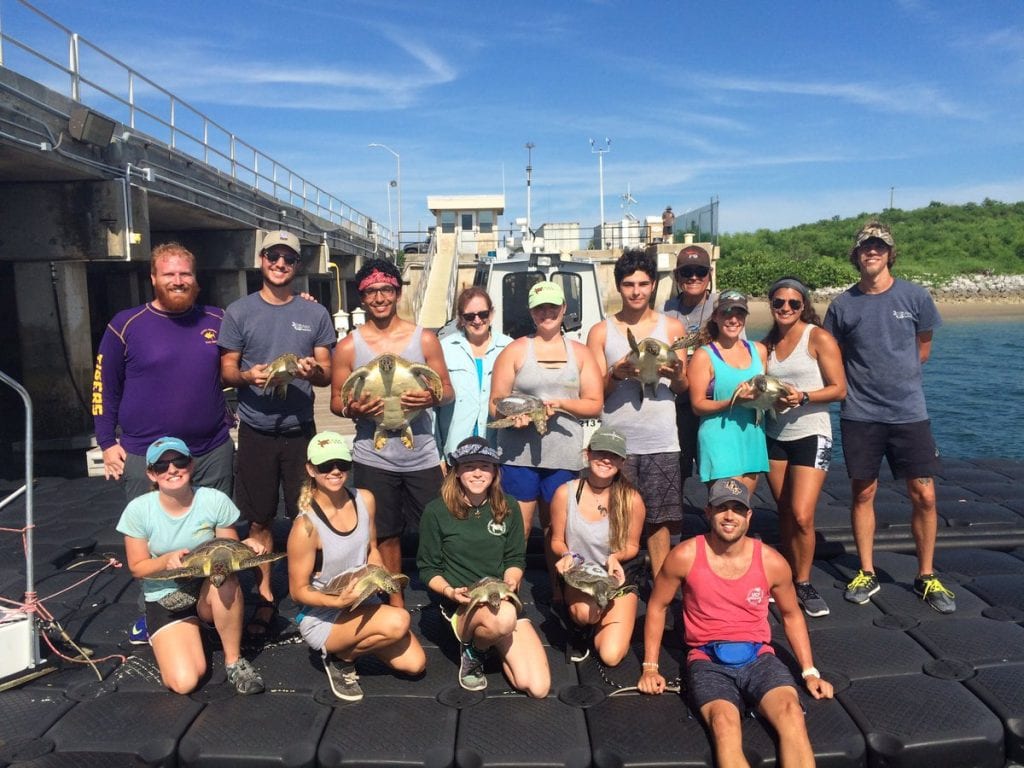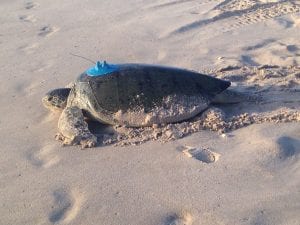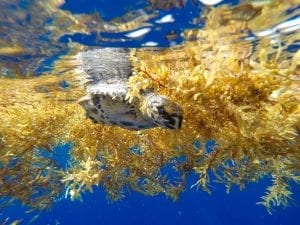Knight Life: The UCF Turtle Team

Credit: MTP-186
It’s 9:30 p.m., the sun is down, and your shift is about to start. You put on your long pants, long-sleeved shirt, bug jacket and fanny pack with your nightly turtle kit. Out on the beach in Brevard County, in the Archie Carr National Wildlife Refuge, you’re starting your search for nesting female sea turtles. You’ll tag them, mark their nests and collect skin samples. When you’re done it’s about 2 a.m., just enough time for a quick nap before the morning shift at 6 a.m. Now it’s time to count how many sea turtles came up on the beach and to see if any of those marked nests hatched. For the ones that hatched a few days ago, you dig in the sand to find the eggs and count the number that hatched or didn’t. Sometimes you get really lucky and there are a few hatchling stragglers to release. This work continues until lunch time.
This is a small glimpse of what it’s like to be part of UCF’s Marine Turtle Research Group. Every year the UCF MTRG conducts research on sea turtle nesting and juveniles on Brevard County’s beaches and Indian River Lagoon. The program has been collecting data along 47 km of Central Florida’s beaches since 1982. Data from the MTRG were used to establish the U.S. Fish and Wildlife Service’s Archie Carr National Wildlife Refuge spanning southern Brevard County and northern Indian River County. All sea turtles are protected under the Endangered Species Act, due to reductions in population and threats to their survival.
The data the MTRG collects provides a snapshot of Florida and north Atlantic loggerhead and green turtle populations. Interns and grad students help tag and document where the turtles go and how many turtles are produced from Brevard County’s beaches—a region known as one of the most important sea turtle rookeries in the Western Hemisphere.

Credit: MTP-186
In addition to nesting beach work, the MTRG crew samples twice a month for juvenile turtles in the Indian River Lagoon. UCF’s in-water program is one of the longest ongoing in-water projects in the world. Erin Seney, Ph.D., part of the MTRG team since 2015 explains why this lagoon work is so important.
“Our work provides information primarily on teenager loggerhead and green turtles, allowing us to assess population trends and health of a different life stage,” she said. “UCF’s multiple life stage approach is especially valuable because it takes turtles 20 to 30 years to mature. We better understand species trends, habitat needs and potential threats.”
For the third time since the 1980s green turtle nest counts are higher than loggerhead nest counts in the refuge. Nest totals as of August 10 are: 20 leatherback nests, 9,039 loggerhead nests and 9,583 green turtle nests. The UCF students and graduate students carry out the strenuous but rewarding work from May through the end of October to help lock in data that helps support statewide index nesting programs and federal sea turtle stock assessments. Working with sea turtles sounds like a dream, but it isn’t easy. Ph.D. student Gustavo Stahelin outlines how being chosen as in intern works, and the process starts with a 10-minute presentation in upper-level undergraduate classes.
“We explain what the internship is about and what to expect,” he said. “We interview those who are interested and during the interview we invite prospective interns to join us for some of our regular field work activities so they can get a better feel of what we do.”
After an application form and a cover letter, graduate students select 12 out of about 80 applications. The lucky dozen are selected to work with former interns and graduate students. Assistant professor of Biology, Kate Mansfield, Ph.D., directs the Martine Turtle Research Group. The group of 21 this summer was one of the best teams she’s seen.

Credit: G. Stahelin, MTP-186
“This year’s group as a whole have been amazing,” she said. “They work incredibly well together and are like a NASCAR pit crew when they work up turtles. This crew includes all the new interns, my grad students, plus a great crew of “returners”—interns who have been with us for at least a season.”
Not every student on the research team is studying turtles or aspiring to be a biologist. This year one of the returning interns is UCF alumna Lesly Cohen. She graduated in Spring 2017 with a bachelor’s degree in Biomedical Sciences. She’s been accepted to veterinarian school at Oregon State University, where she will attend beginning this fall.
Mitchel Meads is an incoming senior and is majoring in biology.
“I was born and raised in Orlando and I’ve spent most of my life in or around the ocean,” Meads said. “I have developed a very strong appreciation and connection the ocean’s importance to this planet and it’s inspired me to pursue a career directed toward saving our marine ecosystems.”
Even though the turtle crew are split up into groups, Stahelin can’t help but echo Mansfield’s praise.
“The type of work we do on the beach is extremely exhausting between weather and hours,” he said. “We never feel like we got enough sleep and it requires a lot of attention and concentration in small details about protocols. Despite all of that our team thrives, collecting an enormous amount of high-quality scientific data.”
